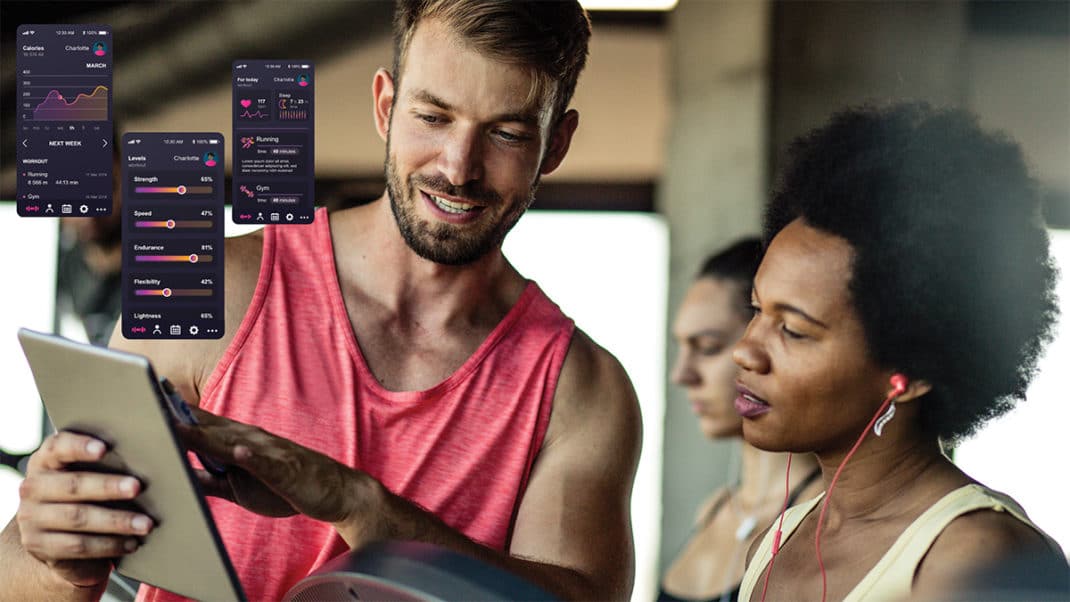Water Fitness Magic: Method, Modeling and Music
Dive deeper into best practices for superior instruction.

Something magical happens when you mix exercise with water. The pool can transform physical activity into something more enjoyable, safe and effective for people of all ages and fitness levels. Buoyancy is a boon to individuals with musculoskeletal issues or other health considerations; it reduces the effects of gravity on weight-bearing joints and provides a supportive, low-impact environment for improving body composition, cardiorespiratory endurance, and muscular strength and flexibility, among other health parameters. At the other end of the spectrum, fitness enthusiasts and high-performing athletes appreciate the cross-training, rehabilitation and active recovery that water provides.
But diving into this magical workout environment isn’t as simple as getting your Tabata™ workout wet. Instructors often overlook the amount of planning, preparation and practice it takes to create an experience that maximizes benefits and keeps students coming back to class.
Water fitness professionals who get it right have a deeper understanding of water fitness methodology and how to apply it to class design and delivery. They’re also skilled at modeling movements from the pool deck so students can translate demonstrations into an outstanding workout. Finally, good instructors leverage music to reach students on an emotional level and inspire them to go “all in.” Creating water fitness magic requires you to take your teaching skills up a notch. Here’s how to bring a new wave of expertise to your water workouts.
Method: Get the Water Moving!
Buoyancy is an easy property to understand. Students feel how it reduces the effects of gravity, making movement more enjoyable. Understanding viscosity, or the “thickness” of water, however, is what will really help you make a splash with your program.
Viscosity offers greater resistance to movement than air does and can be manipulated to provide more or less resistance, depending on the speed and force of movement applied (Becker 2009). Marietta Mehanni, an international aquatic fitness presenter and instructor based in Melbourne, Australia, shares how viscosity enables her to challenge her senior and specialty populations to work harder without the risk of injury. “When people are in the water, they can only go as hard or fast as their fitness level [allows],” she says. Viscosity creates an environment that is self-protective, enabling all populations to progress safely.
To take advantage of water’s natural resistance property, move beyond the basics to teach students how to generate more muscular effort. Mehanni says that after a couple of sessions, students understand buoyancy and how the water environment feels. At that point, it’s time to say, “Now, let’s start moving the water!”
How? To coach students to “move the water,” cue them to create “stiffness” in the arm joints—all the way up the kinetic chain. Mehanni offers a helpful metaphor: “If you want to move water in a basin from one side to the other, you pick up something stiff like a wooden spoon, not a piece of wet spaghetti.” Without joint integrity, the water simply flows around the body without much force. Energy begins in the hands, says Mehanni, so plan and cue specific hand positions for every movement pattern.
Margie Caldwell Cooper, a HYDRO-FIT® master instructor and the Aquatic Exercise Association’s 2006 Aqua Fitness Professional of the Year, further explains the important role the arms play in recruiting muscles on a global level. “When your arms are moving in more shallow water—at shoulder height, for instance—the ‘pushing against the water’ comes mostly from the shoulders and neck,” she says. “As you drop your arms to waist or hip depth, the direction in which you push your arms will ‘speak’ to your core at three points of stability: shoulder blades, abs and glutes.”
Turbulence is another valuable property. Not only does it increase muscular demand; it also creates an unstable environment that challenges core stability and postural alignment. Help your students generate more turbulence by incorporating multiplanar movements into the workout, says Caldwell Cooper. For example, combine a sagittal-plane movement like cross-country skiing with a frontal-plane move (arms that sweep from side to side like a pendulum, for example), to create an “invitation to resist the twist.”
Caldwell Cooper admits it can be challenging for some students to tap into these more nuanced properties and suggests that you cue them to close their eyes to get a better kinesthetic feel for the water’s resistance.
Modeling: Hit the Deck Effectively
If the magic of water lies in mobilizing it, then an instructor’s primary goal is to teach students how to do that correctly. Instructing from the pool deck provides the best vantage point for communication. Students have a better view of you demonstrating the exercises, and you can monitor participants’ efforts. Mehanni says she can see if her students are moving with purpose. “Turbulence is a sign of effort,” she says. “If I don’t see the water moving, then I know my students aren’t giving me full effort, and I need to adjust my approach.”
Teaching from the pool deck is not without its challenges, and it takes practice. Many aquatic environments have poor acoustics, which may make verbal cuing less effective. At the same time, demonstrating from land is difficult because you’re not having the same experience as your students. It’s essential to improve your deck demonstrations to reflect how exercises should be performed in the pool. “You need to look like you’re moving in the water, which means you’re more grounded, you’re moving more slowly, and you’re creating a look of muscular effort,” says Caldwell Cooper.
Mehanni characterizes her demonstrations as miming what it would look like if she were moving a heavy object. “First, I create muscular tension in my body so that I am showing force,” she says. “[My] facial expression shows effort, and perhaps [I’ll even add] a sound effect for emphasis.” Modeling movement correctly should look like hard work, because it is!
Music: Make the Magic Happen
Water fitness often attracts people who struggle to exercise consistently. Caldwell Cooper says uplifting music makes fitness more fun and increases adherence. Instructors who know how to work with both music cadence and musicality—the quality that makes music pleasing to the ear—are the most successful.
Mehanni places music at the core of her planning and teaching. “We cannot ignore that music is the most powerful tool we have to motivate and engage our students,” she says. “People will commit more when they feel emotionally motivated, and music [does] that.”
Both experts say it’s time to move away from the terminology “land tempo” and “water tempo.” Caldwell Cooper says this archaic cue means nothing to participants, and Mehanni agrees. “I don’t talk about land tempo and water tempo. I tell participants to look up at me and perform the movement at the pace I am demonstrating.”
Though the recommended music tempo is 125–150 beats per minute (AEA 2014), it may be time to consider an additional perspective. “I think choosing a particular bpm for a class is backward,” says Mehanni. Instead, she decides on which physiological response she wants to elicit and then matches the tempo. If the focus is on strength or endurance, the music is slower than it is for a cardiovascular response.
Teaching on autopilot to whatever song is next is a missed opportunity to connect students to the joy of movement. “It doesn’t make sense to do sprinting and knee tucks to classical music,” says Mehanni. Instead, she will choreograph a Portuguese song with flamenco-inspired moves or play a country music selection to make students feel like they are line dancing. “I get [better] buy-in from my students when I match the movement to the music, because it brings more joy to the workout.”
Tips for Teaching Success
Mehanni is concerned that many instructors don’t spend enough time in the water gaining a deeper understanding and feel for its unique properties. “If your understanding is compromised, you will not be able to translate effective movement to participants,” she says. A seasoned expert, Mehanni spends a lot of time in the water analyzing and honing her teaching skills to make sure her movement on land is communicated effectively to her students in the water. Her routines engage students on an emotional level, where the seeds of intrinsic motivation lie.
Her biggest tip: Jump in the pool and become acutely aware of how every move you teach from the deck feels in the water. Videotape yourself in action, and then watch and listen to the cues you used as you experienced the movements. Return to the deck, and practice translating that information back into the water for fellow instructors or students, who can then offer feedback. If they struggle to understand, hop back in the water and figure out why.
When she offers this time-consuming process in her workshops, some instructors sigh incredulously and say, “But that seems like such hard work!” To which she replies, “Yes, I know it is. But don’t your participants deserve it?”
Bigger, more exaggerated movements performed at slower tempos get the water moving, which shows effort. Sometimes, kinesthetic learners need more guidance. Margie Caldwell Cooper, a HYDRO-FIT master instructor and the Aquatic Exercise Association’s 2006 Aqua Fitness Professional of the Year, suggests creating a visual cuing experience from the deck to help them. For example, if you want your students to lift their knees higher when they jog, demonstrate lifting the knee high enough to clap underneath. Once they’re doing that, remove the clap and continue modeling the high-knee jog as participants integrate the skill into their muscle memory bank.
Meg Root
I am an ACE certified Group Exercise Instructor and Advanced Health and Fitness Specialist. I work as a wellness coach, speaker, and writer from my home base at Glen Ivy Hot Springs Spa in Corona, CA. I have worked in the spa industry for over 25 years, teaching and offering workshops at premier spas across the country including Rancho La Puerta, in Tecate, Mexico, The Oaks at Ojai, Green Valley Spa, in St. George, Utah, and The Spa at Sea Island, Georgia. I love working with a variety of populations, but I particularly enjoy reaching out to inactive and specialty populations with the message that "One SIMPLE ACT OF WELLNESS is all it takes to make you feel like your Well-Self again!" Please connect with me about my fun and interactive wellness workshops (including titles such as "I Know What I Should Do! I Just Need to Do It!" "Walking Toward Wellness" and "Writing Toward Wellness") which are perfect for employee wellness programs, wellness days, and small group wellness get togethers.





